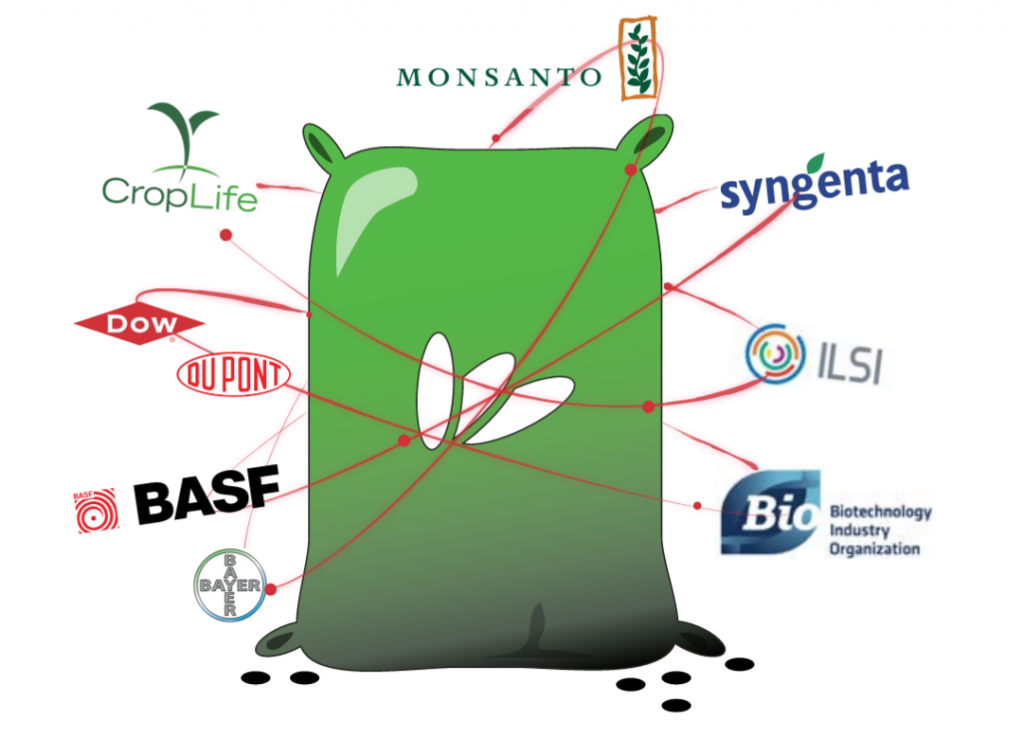


Myth #1: Agro-fuels are clean and green –
Because photosynthesis from fuel crops removes greenhouse gases from the atmosphere and can reduce fossil fuel consumption, we are told fuel crops are green. But, when the full life-cycle of agro-fuels is considered – from land clearing to automotive consumption – the moderate emission savings are undone by far greater emissions from deforestation, burning, peat drainage, cultivation and soil carbon losses. Every ton of palm oil produced results in 33 tons of carbon dioxide emissions — 10 times more than petroleum. Clearing tropical forests for sugarcane ethanol emits 50 percent more greenhouse gases than the production and use of the same amount of gasoline.
There are other environmental problems as well. Industrial agro-fuels require large applications of petroleum-based fertilizers, whose global use has more than doubled the biologically available nitrogen in the world, contributing heavily to the emission of nitrous oxide, a greenhouse gas 300 times more potent than carbon dioxide.
To produce a liter of ethanol takes three to five liters of irrigation water and produces up to 13 liters of waste water. It takes the energy equivalent of 113 liters of natural gas to treat this waste, increasing the likelihood that it will simply be released into the environment. Intensive cultivation of fuel crops also leads to high rates of erosion.



Myth #3: Agro-fuels will bring rural development
In the tropics, 100 hectares dedicated to family farming generates thirty-five jobs. Oil palm
and sugar cane provide 10 jobs, eucalyptus two, and soybeans a scant half-job per 100 hectares, all poorly paid. Until recently, agro-fuels supplied primarily local and sub-regional markets. Even in the U.S., most ethanol plants were relatively small, and farmer-owned. With the agro-fuels boom big industry is quickly moving in, centralizing operations and creating gargantuan economies of scale. Big Oil, Big Grain, and Big Genetic engineering are rapidly consolidating control over the entire agro-fuel value chain. The market power of these corporations is staggering: Cargill and ADM control 65 percent of the global grain trade, Monsanto and Syngenta a quarter of the $60 billion gene-tech industry.
This market power allows these companies to extract profits from the most lucrative and low-risk segments of the value chain, e.g., inputs, processing and distribution. Agro-fuels producers will be increasingly dependent on a tightly-organized cabal of companies for their seed, inputs, services, processing and sale. They are not likely to receive many benefits.
More likely, smallholders will be forced out of the market and off the land. Hundreds of thousands have already been displaced by the soybean plantations in the “Republic of Soy” a 50+ million hectare area covering southern Brazil, northern Argentina, Paraguay, and eastern Bolivia.

Myth #5: Better “second-generation” agro-fuels are just around the corner
Proponents of agro-fuels like to reassure “food versus fuel” skeptics by asserting that present agro-fuels made from food crops will soon be replaced with environmentally-friendly crops like fast-growing trees and switchgrass. This myth, wryly referred to as the “bait and switch-grass” shell game, helps make first generation agro-fuels socially acceptable.
The agro-fuel transition transforms land use on massive scales, pitting food production against fuel production for land, water and resources. The issue of which crops are converted to fuel
is irrelevant. Wild plants cultivated as fuel crops won’t have a smaller “environmental footprint” because commercialization will transform their ecology. They will rapidly migrate from hedgerows and woodlots onto arable lands to be intensively cultivated like any other industrial crop—with all the associated environmental externalities.
By genetically engineering plants with less lignin and cellulose, the industry aims to produce cellulosic agro-fuel crops that break down easily to liberate sugars, especially fast-growing trees. Trees are perennial and spread pollen father than food crops. Cellulosic candidates miscanthus, switch grass, and canary grass, are invasive species. Given the demonstrated promiscuity of genetically-engineered crops, we can expect massive genetic contamination. Monsanto and Syngenta will be quite pleased. Agro-fuels will serve as their genetic Trojan horse, allowing them to fully colonize both our fuel and food systems.
Any technology with potential to avoid the worst impacts of global warming must be commercially viable on a global scale within the next 5-8 years. This is highly unlikely with cellulosic ethanol, a product that has thus far demonstrated no carbon savings. Making it a green, viable product is not simply matter of scaling up existing technology, but of major breakthroughs in plant physiology that permit the economically efficient breakdown of cellulose, hemi-cellulose, and lignin. The agro-fuel industry is either betting on miracles or counting on taxpayer bail-outs. Faith in science is not science. Selective faith in second-generation fuel—rather than working to improve existing solar, wind, or conservation technologies—is bias in favor of the highest bidder.
Biofuel Myths
Are biofuels helpful or hurtful?
Should we use food for fuel?
Are there better ways to solve our need for energy?
What about costs?
What about food? Water? Land?
What can we really do?
There are many reasons why the Green Peace Corps believes that time is of the essence in educating the public and our leaders as well as moving quickly to action. There are “alternatives” being put out in the global community, but are they really helping us and contributing to our economy?
It’s been best put by Mr. Eric Hoit-Gimenez, Indypendent, Posted June 25, 2007:
“Touted by politicians and industry as “green” energy, biofuels come with a high price tag.”
Biofuels invoke an image of renewable abundance that allows industry, politicians, the World Bank, the United Nations and even the Intergovernmental Panel on Climate Change to present fuel from corn, sugarcane, soy and other crops as replacement for oil that will bring about a smooth transition to a renewable economy.
Myths of abundance divert attention from powerful economic interests that benefit from this biofuels transition, avoiding discussions of the growing price that citizens of the global South are beginning to pay to maintain the consumptive oil-based lifestyle of the North. Biofuels mania obscures the profound consequences of the industrial transformation of our food and fuel systems – the agro-fuels transition.


Myth #2: Agro-fuels will not result in deforestation
Proponents of agro-fuels argue that fuel crops planted on ecologically degraded lands will improve rather than destroy the environment. Perhaps the government of Brazil had this in mind when it re-classified some 200 million hectares of dry-tropical forests, grassland, and marshes as “degraded” and apt for cultivation.
In reality, these are the bio-diverse ecosystems of the Mata Atlantica the Cerrado and the Pantanal, occupied by indigenous people, subsistence farmers, and extensive cattle ranches. The introduction of agro-fuel plantations will simply push these communities to the “agricultural frontier” of the Amazon where the devastating patterns of deforestation are all too well-known. Soybeans supply 40 percent of Brazil’s biodiesel. NASA has positively correlated their market price with the destruction of the Amazon rainforest—currently at nearly 325,000 hectares a year. Called “The Diesel of Deforestation,” palm oil plantations for bio-diesel are the primary cause of forest loss in Indonesia, a country with one of the highest deforestation rates in the world.
By 2020, Indonesia’s oil-palm plantations will triple in size to 16.5 million hectares—an area the size of England and Wales combined—resulting in a loss of 98% of forest cover. Neighboring Malaysia, the world’s largest producer of palm oil, has already lost 87% of its tropical forests and continues deforesting at a rate of seven percent a year.



Myth #4: Agro-fuels will not cause hunger
Hunger, said Amartya Sen, results not from scarcity, but poverty. According to the FAO, there is enough food in the world to supply everyone with a daily 3,200-calorie diet of fresh fruit, nuts, vegetables, dairy and meat. Nonetheless, because they are poor, 824 million people continue to go hungry. In 2000, world leaders promised to halve the proportion of hungry people living in extreme poverty by 2015. Little progress has been made. The world’s poorest people already spend 50-80% of their total household income on food. They suffer when high fuel prices push up food prices.
Now, because food and fuel crops are competing over land and resources, high food prices may actually push up fuel prices. Both increase the prices of land and water. This perverse, inflationary spiral puts food and productive resources out of reach for the poor. The International Food Policy Research Institute has estimated that the price of basic food staples will increase 20-33 percent by the year 2010 and 26-135 percent by the year 2020. Caloric consumption typically declines as price rises by a ratio of 1:2. With every 1 percent rise in the cost of food, 16 million people are made food insecure. If current trends continue, some 1.2 billion people could be chronically hungry by 2025—600 million more than previously predicted.
World food aid will not likely come to the rescue because our surpluses will go to our gas tanks. Perversely, food aid only increases when food prices are low, not high. Instead of converting land to fuel production, what are urgently needed are massive transfers of food-producing resources to the rural poor.


